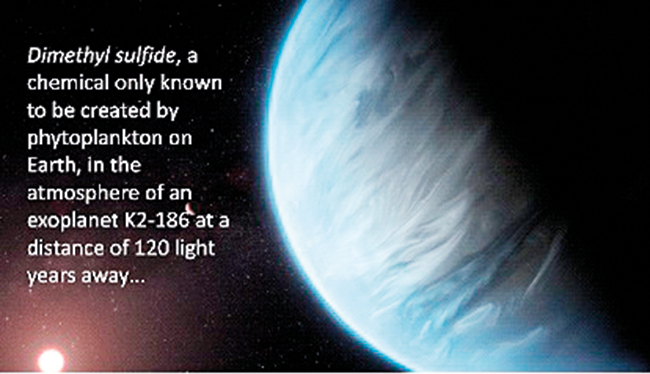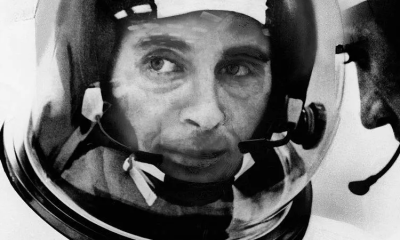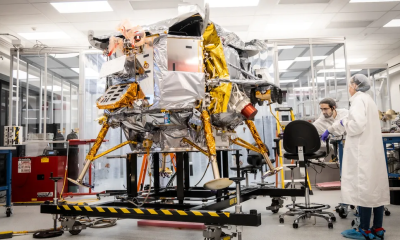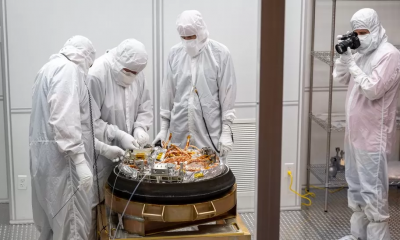Features
THE CASE FOR OUR COSMIC ANCESTRY

New data signals a major paradigm shift in science
by Chandra Wickramasinghe
(Vidya Jyothi Professor Chandra Wickramasinghe, MBE, is an Honorary Professor at the University of Buckingham, UK, Honorary Professor at Ruhuna University, Sri Lanka and Adjunct Professor at the National Institute of Fundamental Science, Sri Lanka)
How did life arise? Not just on the Earth, but anywhere in the Universe? Does life emerge on every Earth-like planet that have oceans and an atmosphere by spontaneous processes involving well understood laws of physics and chemistry? Or did it involve an extraordinary, even miraculous intervention?
How old is the universe itself? How did it originate, if it indeed did ever originate? Is there evidence of life outside the Earth? In comets, the space between stars in our Milky Way galaxy, on other planets, in other galaxies? Science must necessarily exclude miraculous options of course, but the questions continue to be asked and demand answers. Many of these questions have an antiquity that predates Western traditions that go back to classical Greece in the first century BCE. The answers may have a genesis that goes outside the realm of Western culture. The concepts of zero, infinity (Ananta) all have an Indian origin and are inextricably linked with Hinduism and Buddhism. It could well be for this reason that the idea of an infinite universe has been so forcefully resisted in Western science!
In the past six months many strongly-held opinions in science have been challenged by the arrival of new data. We may be now ever closer to finding answers to the age-old questions to our cosmic ancestry and the origin of the universe.
The James Webb Space Telescope (Webb) launched in 2021 is the most powerful astronomical observatory surpassing the range and capabilities of the earlier Hubble Space Telescope. It was designed to see deeper and further into our origins: from the formation of stars and planets, to the birth or possible birth of the Universe itself. Webb is an international partnership between NASA, ESA and CSA.
Discoveries using the new James Webb Telescope have shown the existence of galaxies that are much older than the age of the currently fashionable Big Bang model of the universe itself – a universe which is just 13.8 billion years old, barely three times the age of the Earth.
This unimpressive smudge of light called CEERS-93316 (Fig.1) was observed by the James Webb Telescope and is presumed to be the most distant galaxy at a distance of about 35 billion light years. This latest discovery, amongst others, lend support to ideas of a steady-state universe with an infinite age, or models of the cosmos involving alternating phases of creation and destruction. These emerging models of the cosmos are remarkably in agreement with ancient Vedic, Hindu and Buddhist ideas.
Another equally important paradigm shift that is happening now relates to the question of the origin of life, and the connection between life on Earth and the wider universe. The Kepler Orbiting Telescope in launched in 2009 was dedicated to discovering habitable Earth-like planets in our galaxy outside the solar system. A large number of such habitable planets have been discovered so far, and a few weeks ago the James Web Telescope was deployed to study one of these exoplanets in some detail.
This “Earth-twin” known by the name K2-186 is located some 120 light years from the Earth. The surprising discovery was a molecule called dimethyl sulphide, along with carbon dioxide and methane, in the atmosphere of K2-186 that has been hailed as definite evidence of extraterrestrial life. The argument hinges on the fact that the molecule dimethyl sulphide appears to be only produced by biology on the Earth – by marine plankton in particular. So rather belatedly scientists have accepted that a second living planet exists 120 light years away from the Earth. So, the outstanding question now is how and by what processes did life originate on this planet? Or indeed on any other planet?
The long-held view (going all the way back to Aristotle in the third century BCE) is that life emerged and emerges easily and “naturally” on a planet like Earth (or on K2-186, for that matter) as soon as the “right conditions” prevail. The modern version of this concept that has been defended from the dawn of the 20th century is the so-called “theory of spontaneous generation”. Without any substantive proof for it and a great deal of contrary evidence this concept remains part of the holy grail of biology.
According to this theory of spontaneous generation organic molecules in the Earth’s oceans are supposed to assemble themselves naturally into primitive living systems that subsequently evolve over billions of years to produce the magnificent panorama of life of which we form the most trivial part. Needless to say, there was never any substantive evidence to support this point of view, but nevertheless it was one that has been accepted by the entire establishment of science, more or less like an act of faith.
Experiments to “prove” the process if spontaneous generation and to synthesize life from non-life have continued to be conducted in the most advanced biotechnology laboratories across the world for well over half a century. Every attempt that has been made to replicate the process of spontaneous generation in the laboratory under the widest possible range of conditions has ended in dismal failure. The reason is simple: the probability hurdle needed to go from non-living organics to the simplest evolvable living system is of a scale that is super-astronomical. The origin of life requires a system that transcends the scale of the Earth, our solar system, our Milky Way Galaxy and perhaps involves the entire universe, that is now appearing to be possibly infinite in scale.
The alternative to spontaneous generation of life is the concept of life being a cosmic phenomenon or panspermia as it has come to be called. This basic idea has an antiquity in Western tradition that predates Aristotle and is attributed to the pre-Socratic philosopher Anaxoragas. Anaxoragas suggested that the seeds of life are all pervasive in the cosmos and they take root and develop into living entities whenever the right conditions prevail. This is the theory of Panspermia (from Greek roots: Spermata – seed; Pans – everywhere). Similar ideas are implied in Buddhist, Hindu and Vedic cosmologies and of course these predate the ancient Greeks by many centuries.
From the 1970’s onward the late Sir Fred Hoyle and the present writer became torch bearers for the theory of cosmic life which was a revived form of the ancient theory of panspermia. The starting point in our investigations involved the identification of cosmic dust, the trillions upon trillions of micrometre-sized “dust” that makes up a few percent of the mass of the entire Galaxy, and shows up as conspicuous dark clouds and striation against the background of stars in the Milky Way. By 1984 we had accumulated enough astronomical evidence to conclude that a very large fraction of this cosmic dust in fact linked to life – bacteria and viruses in various stages of decay and degradation, but still largely preserving the information required to initiate life on any habitable Earth-like planet.
Case against spontaneous generation of life
The most powerful single argument for life being a cosmic rather than a purely terrestrial phenomenon was articulated by the late Sir Fred Hoyle way back in 1980, summarizing the position that we had reached at the time:
“The very small probabilities, which one calculates for the assembly of these substances (e.g. enzymes), demonstrates as near to certainty as one would wish that life did not originate here on the Earth. Indeed, the infinitesimal probabilities demonstrate that life is even too complex for its origin to be confined within our galaxy alone. The resources of the whole universe were almost certainly needed……”
If there was a deep principle of nature that drove inorganic systems towards the emergence of primitive life – the evidence for this would have long since been discovered in the laboratory, which as we noted, has not. Moreover, with calculations showing grotesquely low a priori probabilities for the transition from non-life to life only two options remain: –
(1) The origin of life was an extremely improbable event that must have occurred on Earth against all odds (because we are here!) but will consequently not be reproduced elsewhere. In that case we would indeed be hopelessly alone as a life system in the Universe.
(2) Alternatively, a very much vaster cosmic system than was available on Earth, and a very much longer timescale was involved in an initial origination event, after which life was transferred to Earth and elsewhere by processes that the late Sir Fred Hoyle and the present writer proposed many years ago – cometary panspermia.
We then went on to argue that this cosmologically-derived legacy of life, along with its full evolutionary potential (contained within the genomes of bacteria and viruses), were distributed mainly by comets and other repositories of cosmic dust onto habitable planets like the Earth. Comets in this theory are incubators and distributors of the information of life throughout the universe in the form of bacteria and viruses.
Whilst in 2023 comets are conceded by most scientists as being the repositories of complex organic molecules that may have contributed to spontaneous generation of life, their role as carriers of life itself, despite an ever-increasing body of contrary evidence is still fiercely resisted. Hard evidence of comets containing organic molecules that can only reasonably be derived from biology are coming in fast and thick. The Rosetta Space Mission to a comet – Comet 67P/C-G – launched in 2013 has yielded a formidable body of evidence, all showing consistency with the existence of microbial material in comets.
Another comet, Comet Lovejoy, has more recently been observed and found to be emitting large amounts of ethyl alcohol as well as a type of sugar into space – equivalent to 500 bottles of wine per second. These are the natural products of fermentation, which is clear evidence for sub-surface microbial activity in a comet.
Are cosmic bacteria continually falling to Earth?
One crucial test of the theory of cosmic life is to probe the stratosphere for in-falling alien genetic systems – bacteria and viruses. To urge international space authorities with the capability of doing this was far from easy. The first dedicated effort to test the idea of bacterial in-fall from comets was carried out in collaboration with scientists at ISRO (Indian Space Research Organisation) in 2001.
Positive detections of in-falling microbiota were made, and the number of bacterial cells collected in a measured volume of the stratosphere at 41km led to an estimate of an in-fall rate over the whole Earth of 0.3-3 tonnes of microbes per day. This converts to some 20-200 million bacteria per square metre arriving from space every single day.
Very recently microorganisms were discovered on many occasions between 2013 and 2017 on the outside of the International Space Station that orbits at 400km above the Earth. There is no easy way to maintain that such microorganisms could have been lofted from the surface of the Earth.
This discovery is so profoundly important for science that it needs to be repeated; but the desire to repeat it is difficult to find. A similar experiment, however, is being planned by a team of scientists led by Professor Dhammika Maganarachchi at the National Institute of Fundamental Studies and myself. A balloon launch to this end is being planned within the next six months. The team at NIFS will be assisted by my grandson, Reuben Chandra Wickramasinghe, who has a visiting appointment at the Mathematics Department of the University of Colombo.
Concluding remarks
I believe that in 2023 we have reached a crucial turning point in the history of human civilization. When it is finally accepted that life on Earth is a minuscule part of a vast cosmic biosphere the implications for humanity will be profound. Even more important would be the recognition that alien life in the form of microbes – bacteria and viruses – exist in our very midst even now and are continually raining down on our planet. Such microbes could be responsible for devastating pandemics, but more positively, we should recognise cosmic viruses and bacteria could have the potential to augment our genomes – the genomes of all terrestrial lifeforms – and over long periods unravel an ever-changing panorama of cosmic life.
Whilst advances in technology continue at accelerating pace humanity as a whole is becoming ever more fractured. Wars and bitter sectarian conflicts and heart-rending suffering are to be seen everywhere. The “climate-change” marches and protestations of young people that are gaining momentum are perhaps emblematic of a desire to rebel against reigning paradigms that seem to be threatening our very existence.
Thomas Kuhn famously declared “…when paradigms change, the world changes with them.” One could perhaps assert that a reversal of this causality is also possible – “when the world changes paradigms can be forced to change.”
Further reading
Wickramasinghe, N.C. and Wickramasinghe, R.C., 2023. Life and the Universe: a final synthesis, Journal of Cosmology, Vol. 30, No.10, pp. 30160 – 30174
Wickramasinghe, C., Wickramasinghe, K., Tokoro, G., 2019. Our Cosmic Ancestry in the Stars (Inner Traditions, NY)
Features
The heart-friendly health minister

by Dr Gotabhya Ranasinghe
Senior Consultant Cardiologist
National Hospital Sri Lanka
When we sought a meeting with Hon Dr. Ramesh Pathirana, Minister of Health, he graciously cleared his busy schedule to accommodate us. Renowned for his attentive listening and deep understanding, Minister Pathirana is dedicated to advancing the health sector. His openness and transparency exemplify the qualities of an exemplary politician and minister.
Dr. Palitha Mahipala, the current Health Secretary, demonstrates both commendable enthusiasm and unwavering support. This combination of attributes makes him a highly compatible colleague for the esteemed Minister of Health.
Our discussion centered on a project that has been in the works for the past 30 years, one that no other minister had managed to advance.
Minister Pathirana, however, recognized the project’s significance and its potential to revolutionize care for heart patients.
The project involves the construction of a state-of-the-art facility at the premises of the National Hospital Colombo. The project’s location within the premises of the National Hospital underscores its importance and relevance to the healthcare infrastructure of the nation.
This facility will include a cardiology building and a tertiary care center, equipped with the latest technology to handle and treat all types of heart-related conditions and surgeries.
Securing funding was a major milestone for this initiative. Minister Pathirana successfully obtained approval for a $40 billion loan from the Asian Development Bank. With the funding in place, the foundation stone is scheduled to be laid in September this year, and construction will begin in January 2025.
This project guarantees a consistent and uninterrupted supply of stents and related medications for heart patients. As a result, patients will have timely access to essential medical supplies during their treatment and recovery. By securing these critical resources, the project aims to enhance patient outcomes, minimize treatment delays, and maintain the highest standards of cardiac care.
Upon its fruition, this monumental building will serve as a beacon of hope and healing, symbolizing the unwavering dedication to improving patient outcomes and fostering a healthier society.We anticipate a future marked by significant progress and positive outcomes in Sri Lanka’s cardiovascular treatment landscape within the foreseeable timeframe.
Features
A LOVING TRIBUTE TO JESUIT FR. ALOYSIUS PIERIS ON HIS 90th BIRTHDAY

by Fr. Emmanuel Fernando, OMI
Jesuit Fr. Aloysius Pieris (affectionately called Fr. Aloy) celebrated his 90th birthday on April 9, 2024 and I, as the editor of our Oblate Journal, THE MISSIONARY OBLATE had gone to press by that time. Immediately I decided to publish an article, appreciating the untiring selfless services he continues to offer for inter-Faith dialogue, the renewal of the Catholic Church, his concern for the poor and the suffering Sri Lankan masses and to me, the present writer.
It was in 1988, when I was appointed Director of the Oblate Scholastics at Ampitiya by the then Oblate Provincial Fr. Anselm Silva, that I came to know Fr. Aloy more closely. Knowing well his expertise in matters spiritual, theological, Indological and pastoral, and with the collaborative spirit of my companion-formators, our Oblate Scholastics were sent to Tulana, the Research and Encounter Centre, Kelaniya, of which he is the Founder-Director, for ‘exposure-programmes’ on matters spiritual, biblical, theological and pastoral. Some of these dimensions according to my view and that of my companion-formators, were not available at the National Seminary, Ampitiya.
Ever since that time, our Oblate formators/ accompaniers at the Oblate Scholasticate, Ampitiya , have continued to send our Oblate Scholastics to Tulana Centre for deepening their insights and convictions regarding matters needed to serve the people in today’s context. Fr. Aloy also had tried very enthusiastically with the Oblate team headed by Frs. Oswald Firth and Clement Waidyasekara to begin a Theologate, directed by the Religious Congregations in Sri Lanka, for the contextual formation/ accompaniment of their members. It should very well be a desired goal of the Leaders / Provincials of the Religious Congregations.
Besides being a formator/accompanier at the Oblate Scholasticate, I was entrusted also with the task of editing and publishing our Oblate journal, ‘The Missionary Oblate’. To maintain the quality of the journal I continue to depend on Fr. Aloy for his thought-provoking and stimulating articles on Biblical Spirituality, Biblical Theology and Ecclesiology. I am very grateful to him for his generous assistance. Of late, his writings on renewal of the Church, initiated by Pope St. John XX111 and continued by Pope Francis through the Synodal path, published in our Oblate journal, enable our readers to focus their attention also on the needed renewal in the Catholic Church in Sri Lanka. Fr. Aloy appreciated very much the Synodal path adopted by the Jesuit Pope Francis for the renewal of the Church, rooted very much on prayerful discernment. In my Religious and presbyteral life, Fr.Aloy continues to be my spiritual animator / guide and ongoing formator / acccompanier.
Fr. Aloysius Pieris, BA Hons (Lond), LPh (SHC, India), STL (PFT, Naples), PhD (SLU/VC), ThD (Tilburg), D.Ltt (KU), has been one of the eminent Asian theologians well recognized internationally and one who has lectured and held visiting chairs in many universities both in the West and in the East. Many members of Religious Congregations from Asian countries have benefited from his lectures and guidance in the East Asian Pastoral Institute (EAPI) in Manila, Philippines. He had been a Theologian consulted by the Federation of Asian Bishops’ Conferences for many years. During his professorship at the Gregorian University in Rome, he was called to be a member of a special group of advisers on other religions consulted by Pope Paul VI.
Fr. Aloy is the author of more than 30 books and well over 500 Research Papers. Some of his books and articles have been translated and published in several countries. Among those books, one can find the following: 1) The Genesis of an Asian Theology of Liberation (An Autobiographical Excursus on the Art of Theologising in Asia, 2) An Asian Theology of Liberation, 3) Providential Timeliness of Vatican 11 (a long-overdue halt to a scandalous millennium, 4) Give Vatican 11 a chance, 5) Leadership in the Church, 6) Relishing our faith in working for justice (Themes for study and discussion), 7) A Message meant mainly, not exclusively for Jesuits (Background information necessary for helping Francis renew the Church), 8) Lent in Lanka (Reflections and Resolutions, 9) Love meets wisdom (A Christian Experience of Buddhism, 10) Fire and Water 11) God’s Reign for God’s poor, 12) Our Unhiddden Agenda (How we Jesuits work, pray and form our men). He is also the Editor of two journals, Vagdevi, Journal of Religious Reflection and Dialogue, New Series.
Fr. Aloy has a BA in Pali and Sanskrit from the University of London and a Ph.D in Buddhist Philosophy from the University of Sri Lankan, Vidyodaya Campus. On Nov. 23, 2019, he was awarded the prestigious honorary Doctorate of Literature (D.Litt) by the Chancellor of the University of Kelaniya, the Most Venerable Welamitiyawe Dharmakirthi Sri Kusala Dhamma Thera.
Fr. Aloy continues to be a promoter of Gospel values and virtues. Justice as a constitutive dimension of love and social concern for the downtrodden masses are very much noted in his life and work. He had very much appreciated the commitment of the late Fr. Joseph (Joe) Fernando, the National Director of the Social and Economic Centre (SEDEC) for the poor.
In Sri Lanka, a few religious Congregations – the Good Shepherd Sisters, the Christian Brothers, the Marist Brothers and the Oblates – have invited him to animate their members especially during their Provincial Congresses, Chapters and International Conferences. The mainline Christian Churches also have sought his advice and followed his seminars. I, for one, regret very much, that the Sri Lankan authorities of the Catholic Church –today’s Hierarchy—- have not sought Fr.
Aloy’s expertise for the renewal of the Catholic Church in Sri Lanka and thus have not benefited from the immense store of wisdom and insight that he can offer to our local Church while the Sri Lankan bishops who governed the Catholic church in the immediate aftermath of the Second Vatican Council (Edmund Fernando OMI, Anthony de Saram, Leo Nanayakkara OSB, Frank Marcus Fernando, Paul Perera,) visited him and consulted him on many matters. Among the Tamil Bishops, Bishop Rayappu Joseph was keeping close contact with him and Bishop J. Deogupillai hosted him and his team visiting him after the horrible Black July massacre of Tamils.
Features
A fairy tale, success or debacle

Sri Lanka-Singapore Free Trade Agreement
By Gomi Senadhira
senadhiragomi@gmail.com
“You might tell fairy tales, but the progress of a country cannot be achieved through such narratives. A country cannot be developed by making false promises. The country moved backward because of the electoral promises made by political parties throughout time. We have witnessed that the ultimate result of this is the country becoming bankrupt. Unfortunately, many segments of the population have not come to realize this yet.” – President Ranil Wickremesinghe, 2024 Budget speech
Any Sri Lankan would agree with the above words of President Wickremesinghe on the false promises our politicians and officials make and the fairy tales they narrate which bankrupted this country. So, to understand this, let’s look at one such fairy tale with lots of false promises; Ranil Wickremesinghe’s greatest achievement in the area of international trade and investment promotion during the Yahapalana period, Sri Lanka-Singapore Free Trade Agreement (SLSFTA).
It is appropriate and timely to do it now as Finance Minister Wickremesinghe has just presented to parliament a bill on the National Policy on Economic Transformation which includes the establishment of an Office for International Trade and the Sri Lanka Institute of Economics and International Trade.
Was SLSFTA a “Cleverly negotiated Free Trade Agreement” as stated by the (former) Minister of Development Strategies and International Trade Malik Samarawickrama during the Parliamentary Debate on the SLSFTA in July 2018, or a colossal blunder covered up with lies, false promises, and fairy tales? After SLSFTA was signed there were a number of fairy tales published on this agreement by the Ministry of Development Strategies and International, Institute of Policy Studies, and others.
However, for this article, I would like to limit my comments to the speech by Minister Samarawickrama during the Parliamentary Debate, and the two most important areas in the agreement which were covered up with lies, fairy tales, and false promises, namely: revenue loss for Sri Lanka and Investment from Singapore. On the other important area, “Waste products dumping” I do not want to comment here as I have written extensively on the issue.
1. The revenue loss
During the Parliamentary Debate in July 2018, Minister Samarawickrama stated “…. let me reiterate that this FTA with Singapore has been very cleverly negotiated by us…. The liberalisation programme under this FTA has been carefully designed to have the least impact on domestic industry and revenue collection. We have included all revenue sensitive items in the negative list of items which will not be subject to removal of tariff. Therefore, 97.8% revenue from Customs duty is protected. Our tariff liberalisation will take place over a period of 12-15 years! In fact, the revenue earned through tariffs on goods imported from Singapore last year was Rs. 35 billion.
The revenue loss for over the next 15 years due to the FTA is only Rs. 733 million– which when annualised, on average, is just Rs. 51 million. That is just 0.14% per year! So anyone who claims the Singapore FTA causes revenue loss to the Government cannot do basic arithmetic! Mr. Speaker, in conclusion, I call on my fellow members of this House – don’t mislead the public with baseless criticism that is not grounded in facts. Don’t look at petty politics and use these issues for your own political survival.”
I was surprised to read the minister’s speech because an article published in January 2018 in “The Straits Times“, based on information released by the Singaporean Negotiators stated, “…. With the FTA, tariff savings for Singapore exports are estimated to hit $10 million annually“.
As the annual tariff savings (that is the revenue loss for Sri Lanka) calculated by the Singaporean Negotiators, Singaporean $ 10 million (Sri Lankan rupees 1,200 million in 2018) was way above the rupees’ 733 million revenue loss for 15 years estimated by the Sri Lankan negotiators, it was clear to any observer that one of the parties to the agreement had not done the basic arithmetic!
Six years later, according to a report published by “The Morning” newspaper, speaking at the Committee on Public Finance (COPF) on 7th May 2024, Mr Samarawickrama’s chief trade negotiator K.J. Weerasinghehad had admitted “…. that forecasted revenue loss for the Government of Sri Lanka through the Singapore FTA is Rs. 450 million in 2023 and Rs. 1.3 billion in 2024.”
If these numbers are correct, as tariff liberalisation under the SLSFTA has just started, we will pass Rs 2 billion very soon. Then, the question is how Sri Lanka’s trade negotiators made such a colossal blunder. Didn’t they do their basic arithmetic? If they didn’t know how to do basic arithmetic they should have at least done their basic readings. For example, the headline of the article published in The Straits Times in January 2018 was “Singapore, Sri Lanka sign FTA, annual savings of $10m expected”.
Anyway, as Sri Lanka’s chief negotiator reiterated at the COPF meeting that “…. since 99% of the tariffs in Singapore have zero rates of duty, Sri Lanka has agreed on 80% tariff liberalisation over a period of 15 years while expecting Singapore investments to address the imbalance in trade,” let’s turn towards investment.
Investment from Singapore
In July 2018, speaking during the Parliamentary Debate on the FTA this is what Minister Malik Samarawickrama stated on investment from Singapore, “Already, thanks to this FTA, in just the past two-and-a-half months since the agreement came into effect we have received a proposal from Singapore for investment amounting to $ 14.8 billion in an oil refinery for export of petroleum products. In addition, we have proposals for a steel manufacturing plant for exports ($ 1 billion investment), flour milling plant ($ 50 million), sugar refinery ($ 200 million). This adds up to more than $ 16.05 billion in the pipeline on these projects alone.
And all of these projects will create thousands of more jobs for our people. In principle approval has already been granted by the BOI and the investors are awaiting the release of land the environmental approvals to commence the project.
I request the Opposition and those with vested interests to change their narrow-minded thinking and join us to develop our country. We must always look at what is best for the whole community, not just the few who may oppose. We owe it to our people to courageously take decisions that will change their lives for the better.”
According to the media report I quoted earlier, speaking at the Committee on Public Finance (COPF) Chief Negotiator Weerasinghe has admitted that Sri Lanka was not happy with overall Singapore investments that have come in the past few years in return for the trade liberalisation under the Singapore-Sri Lanka Free Trade Agreement. He has added that between 2021 and 2023 the total investment from Singapore had been around $162 million!
What happened to those projects worth $16 billion negotiated, thanks to the SLSFTA, in just the two-and-a-half months after the agreement came into effect and approved by the BOI? I do not know about the steel manufacturing plant for exports ($ 1 billion investment), flour milling plant ($ 50 million) and sugar refinery ($ 200 million).
However, story of the multibillion-dollar investment in the Petroleum Refinery unfolded in a manner that would qualify it as the best fairy tale with false promises presented by our politicians and the officials, prior to 2019 elections.
Though many Sri Lankans got to know, through the media which repeatedly highlighted a plethora of issues surrounding the project and the questionable credentials of the Singaporean investor, the construction work on the Mirrijiwela Oil Refinery along with the cement factory began on the24th of March 2019 with a bang and Minister Ranil Wickremesinghe and his ministers along with the foreign and local dignitaries laid the foundation stones.
That was few months before the 2019 Presidential elections. Inaugurating the construction work Prime Minister Ranil Wickremesinghe said the projects will create thousands of job opportunities in the area and surrounding districts.
The oil refinery, which was to be built over 200 acres of land, with the capacity to refine 200,000 barrels of crude oil per day, was to generate US$7 billion of exports and create 1,500 direct and 3,000 indirect jobs. The construction of the refinery was to be completed in 44 months. Four years later, in August 2023 the Cabinet of Ministers approved the proposal presented by President Ranil Wickremesinghe to cancel the agreement with the investors of the refinery as the project has not been implemented! Can they explain to the country how much money was wasted to produce that fairy tale?
It is obvious that the President, ministers, and officials had made huge blunders and had deliberately misled the public and the parliament on the revenue loss and potential investment from SLSFTA with fairy tales and false promises.
As the president himself said, a country cannot be developed by making false promises or with fairy tales and these false promises and fairy tales had bankrupted the country. “Unfortunately, many segments of the population have not come to realize this yet”.
(The writer, a specialist and an activist on trade and development issues . )


























